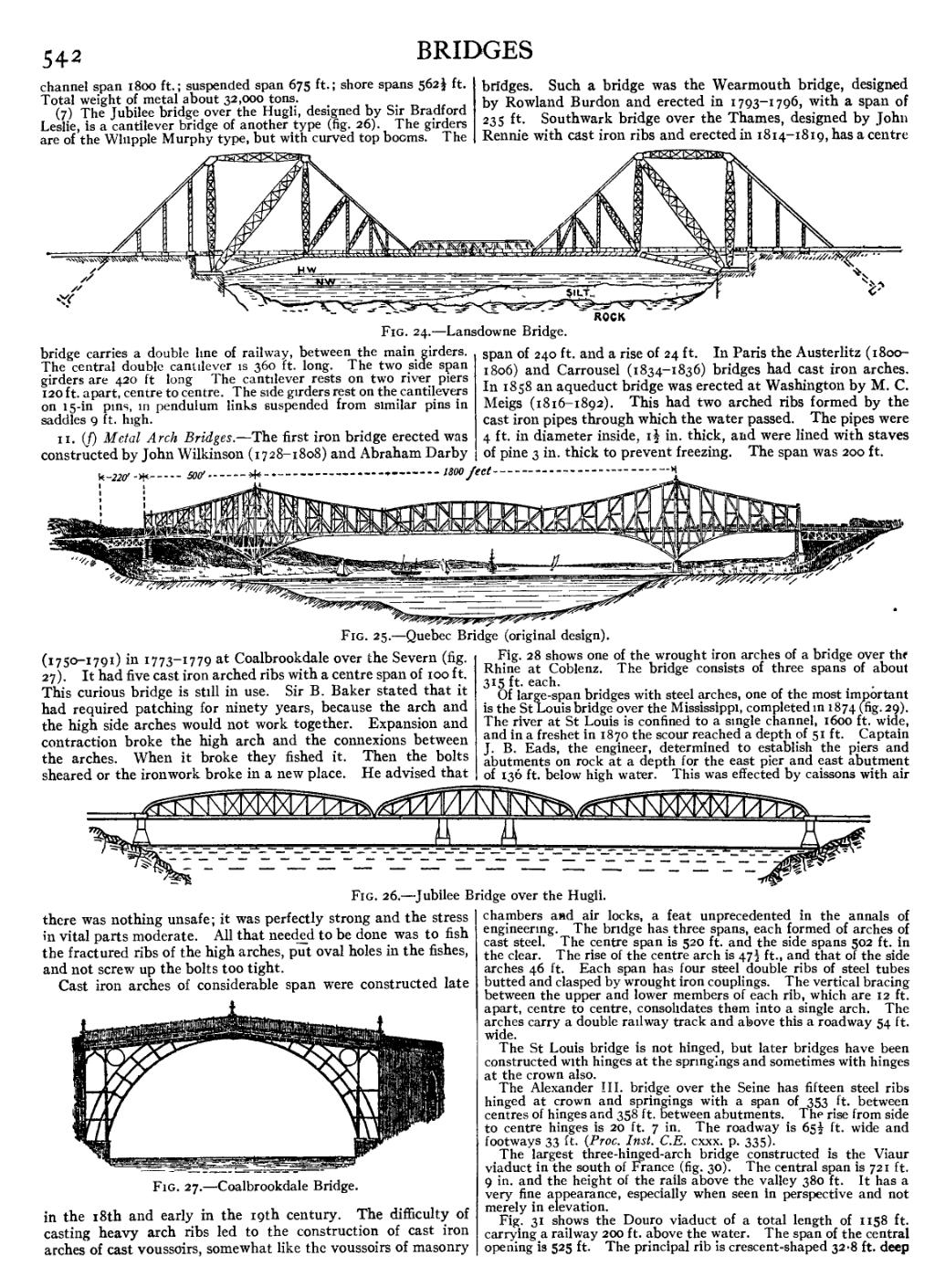channel span 1800 ft.; suspended span 675 ft.; shore spans 5621/2 ft. Total weight of metal about 32,000 tons.
(7) The Jubilee bridge over the Hugli, designed by Sir Bradford Leslie, is a cantilever bridge of another type (fig. 26). The girders are of the Whipple Murphy type, but with curved top booms. The bridge carries a double line of railway, between the main girders. The central double cantilever is 360 ft. long. The two side span girders are 420 ft. long. The cantilever rests on two river piers 120 ft. apart, centre to centre. The side girders rest on the cantilevers on 15 in. pins, in pendulum links suspended from similar pins in saddles 9 ft. high.
11. (f) Metal Arch Bridges.—The first iron bridge erected was constructed by John Wilkinson (1728–1808) and Abraham Darby (1750–1791) in 1773–1779 at Coalbrookdale over the Severn (fig. 27). It had five cast iron arched ribs with a centre span of 100 ft. This curious bridge is still in use. Sir B. Baker stated that it had required patching for ninety years, because the arch and the high side arches would not work together. Expansion and contraction broke the high arch and the connexions between the arches. When it broke they fished it. Then the bolts sheared or the ironwork broke in a new place. He advised that there was nothing unsafe; it was perfectly strong and the stress in vital parts moderate. All that needed to be done was to fish the fractured ribs of the high arches, put oval holes in the fishes, and not screw up the bolts too tight.
Cast iron arches of considerable span were constructed late in the 18th and early in the 19th century. The difficulty of casting heavy arch ribs led to the construction of cast iron arches of cast voussoirs, somewhat like the voussoirs of masonry bridges. Such a bridge was the Wearmouth bridge, designed by Rowland Burdon and erected in 1793–1796, with a span of 235 ft. Southwark bridge over the Thames, designed by John Rennie with cast iron ribs and erected in 1814–1819, has a centre span of 240 ft. and a rise of 24 ft. In Paris the Austerlitz (1800–1806) and Carrousel (1834–1836) bridges had cast iron arches. In 1858 an aqueduct bridge was erected at Washington by M. C. Meigs (1816–1892). This had two arched ribs formed by the cast iron pipes through which the water passed. The pipes were 4 ft. in diameter inside, 11/2 in. thick, and were lined with staves of pine 3 in. thick to prevent freezing. The span was 200 ft.
Fig. 28 shows one of the wrought iron arches of a bridge over the Rhine at Coblenz. The bridge consists of three spans of about 315 ft. each.
Of large-span bridges with steel arches, one of the most important is the St Louis bridge over the Mississippi, completed in 1874 (fig. 29). The river at St Louis is confined to a single channel, 1600 ft. wide, and in a freshet in 1870 the scour reached a depth of 51 ft. Captain J. B. Eads, the engineer, determined to establish the piers and abutments on rock at a depth for the east pier and east abutment of 136 ft. below high water. This was effected by caissons with air chambers and air locks, a feat unprecedented in the annals of engineering. The bridge has three spans, each formed of arches of cast steel. The centre span is 520 ft. and the side spans 502 ft. in the clear. The rise of the centre arch is 471/2 ft., and that of the side arches 46 ft. Each span has four steel double ribs of steel tubes butted and clasped by wrought iron couplings. The vertical bracing between the upper and lower members of each rib, which are 12 ft. apart, centre to centre, consolidates them into a single arch. The arches carry a double railway track and above this a roadway 54 ft. wide.
The St Louis bridge is not hinged, but later bridges have been constructed with hinges at the springings and sometimes with hinges at the crown also.
The Alexander III. bridge over the Seine has fifteen steel ribs hinged at crown and springings with a span of 353 ft. between centres of hinges and 358 ft. between abutments. The rise from side to centre hinges is 20 ft. 7 in. The roadway is 651/2 ft. wide and footways 33 ft. (Proc. Inst. C.E. cxxx. p. 335).
The largest three-hinged-arch bridge constructed is the Viaur viaduct in the south of France (fig. 30). The central span is 721 ft. 9 in. and the height of the rails above the valley 380 ft. It has a very fine appearance, especially when seen in perspective and not merely in elevation.
Fig. 31 shows the Douro viaduct of a total length of 1158 ft. carrying a railway 200 ft. above the water. The span of the central opening is 525 ft. The principal rib is crescent-shaped 32.8 ft. deep





